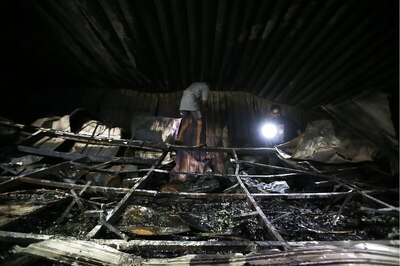
views
Washington: US lawmakers in the House of Representatives on Monday voted against the biggest proposed government intervention in the U.S. economy since the Great Depression of 1929.
Government officials, Treasury chiefs and political leaders from both sides of the political divide thought they had agreed Sunday on the details of a $700-billion rescue plan that would prop up the nation's ailing financial system -- and be supported in the House of Representatives.
As it became apparent the vote was lost, the Dow plummeted about 500 points on Monday.
US President George W Bush earlier pressured lawmakers, saying the plan was of "tremendous importance to all Americans."
He said it would address "the root causes of the financial crisis" and "restore strength and stability to the US financial system." He also urged lawmakers to pass the bill promptly.
"A vote for this bill is a vote to prevent economic damage to you and your community," Bush said.
The Senate is scheduled to vote on the bill on Wednesday.
"Today is the decision day," said Barney Frank, a Democratic Congressman for Massachusetts, on the House floor. "If we defeat this bill today, it will be a very bad day for the financial sector of the American economy and the people who will feel the pain are not the top bankers and top corporate executives but average Americans."
When leading House Republicans signed on to the proposal Sunday after earlier reservations, the bill was expected to pass.
Governments, markets and businesses around the world were watching developments in Washington closely amid fears that failure to tackle the crisis on Wall Street could have disastrous repercussions for the entire global economy.
Markets tumbled again on Monday, affected by continuing uncertainty over the US bailout plan and fresh anxiety over the long term consequences of so-called "toxic debts" which have already brought many established financial names to their knees.What is in the Rescue Bill:
In the span of just 11 days, the Bush administration and lawmakers, seeing ominous warnings in the credit markets, rushed to create legislation to prevent a potential economic meltdown.
The result: A $700-billion bailout package that aims to get financial institutions lending again by letting the US Treasury buy up their troubled assets, most of which are tied to the housing market crash.
After much contentious debate and the addition of several taxpayer protections to the bill, the House scheduled the vote on the legislation Monday and the Senate will follow, likely on Wednesday.Here's a quick breakdown of some of the bill's key provisions:Doling the money out: The $700-billion would be disbursed in stages, with $250 billion made available immediately for the Treasury's use. Authority to use the money would expire on December 31, 2009, unless Congress certifies a one-year extension.Protecting taxpayers: The ultimate cost to the taxpayer is not expected to be near the amount the Treasury invests in the program. That's because the government would buy assets that have underlying value.
If the Treasury pays fair market value - which investors have had a hard time determining - taxpayers stand a chance to break even or even make a profit if those assets throw off income or appreciate in value by the time the government sells them. If it overpays for the assets, the government could be left with a net loss but would get something back on the open market for the assets when it eventually sells them.
If it ends up with a net loss, however, the bill says the president must propose legislation to recoup money from the financial industry if the rescue plan results in net losses to taxpayers five years after the plan is enacted.
In addition, Treasury would be allowed to take ownership stakes in participating companies.Stemming foreclosures: The bill calls for the government, as an owner of a large number of mortgage securities, to exert influence on loan servicers to modify more troubled loans.
In cases where the government buys troubled mortgage loans directly from banks, it can adjust them more easily.Limiting executive pay: Curbs would be placed on the compensation of executives at companies that sell mortgage assets to the Treasury. Among them, companies that participate will not be able to deduct the salary they pay to executives above $500,000.
They also will not be allowed to write new contracts that allow for "golden parachutes" for their top 5 executives if they are fired or the company goes belly up. But the executives' current contracts, which may include golden parachutes, would still stand.Overseeing the program: The bill would establish two oversight boards.
The Financial Stability Oversight Board would be charged with ensuring the policies implemented protect taxpayers and are in the economic interests of the United States. It will include the Federal Reserve chairman, the Securities and Exchange Commission chairman, the Federal Home Finance Agency director, the Housing and Urban Development secretary and the Treasury secretary.
A congressional oversight panel would be charged with reviewing the state of financial markets, the regulatory system and the Treasury's use of its authority under the rescue plan. Sitting on the panel would be 5 outside experts appointed by House and Senate leaders.Insuring against losses: Treasury must establish an insurance program - with risk-based premiums paid by the industry - to guarantee companies' troubled assets, including mortgage-backed securities, purchased before March 14, 2008.
The amount the Treasury would spend to cover losses minus company-paid premiums would come out of the $700 billion the Treasury is allowed to use for the rescue plan.With inputs from CNN.Money.com


















Comments
0 comment